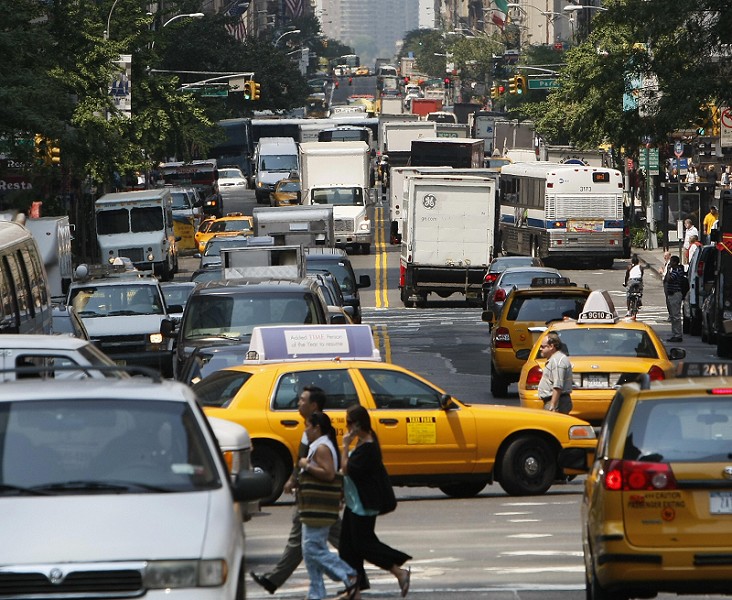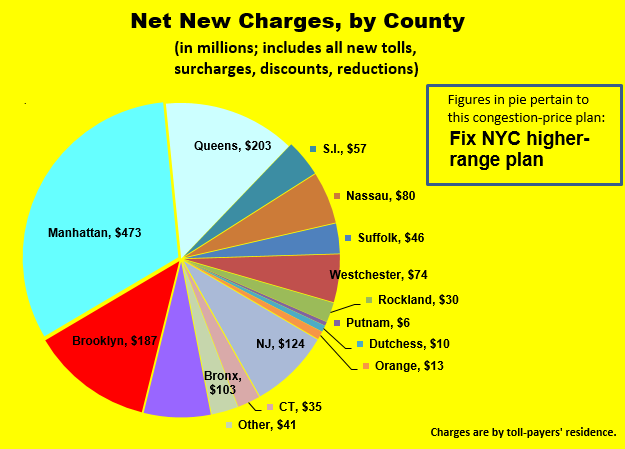What will it cost to implement Andy Byford's Fast Forward NYC plan to modernize NYC Transit? Initial estimates range from $19 billion to $37 billion. Whatever the final price tag, a trainload of new capital will be needed to pay for it. Congestion pricing revenues may not cover every cent, but they’ll need to be the centerpiece of any funding package.
After this year's Albany budget negotiations came and went without Governor Cuomo putting any muscle behind his proclamation that congestion pricing’s time had come, the Byford plan has set the stage for 2019.
The electoral pressure will be off, with no contests for municipal, state, or federal office in November to send politicians scurrying for safe ground. There's a congestion pricing proposal waiting in the wings -- the recommendations from Cuomo's own Fix NYC panel (the numbers in this post are based on a version of those recommendations I call the "Higher Range Plan" -- see note below). And in Byford, there's a well-respected leader at NYC Transit the public can trust to put congestion pricing revenues to good use.
During this window of opportunity, advocates will need to communicate the case for congestion pricing clearly and firmly. Here are eight benefits I see as central.
1. Revenue: $1.5 billion each year
The Fix NYC Higher-Range Plan will net an estimated $1.5 billion a year -- more if we count turnstile clicks from new subway trips eventually attracted by better service, less if we deduct revenues already in the pipeline from for-hire vehicle surcharges mandated in the 2019 state budget.
2. Upfront capital: $20 billion
The annual “stream” of congestion revenue can service bonds to pay for the new signals and other enhancements in the Fast Forward plan. Interest rates on those bonds will likely be between 4 and 5 percent, a range implying the annual $1.5 billion in revenue can service $22 billion to $26 billion in new capital investment. Even playing it safe and lowering that number to $20 billion, congestion pricing is clearly capable of shouldering most of Fast Forward’s capital cost.
3. No other funding mechanism comes close
Raising $1.5 billion a year without congestion pricing means tacking an extra 0.7 percent onto the 8.875 percent total sales tax charged in the 12 MTA counties, or boosting gasoline taxes in those counties by 50 cents a gallon. Or charging each car and truck registered in the five boroughs an additional $800 a year. Or doubling the rate of de Blasio’s millionaires tax, which would generate only $750 million a year as the mayor has proposed it.
4. Economically progressive
The Community Service Society, a venerated champion for poor New Yorkers, dismembered the “regressive” rap on congestion pricing last October with a report documenting that nearly 40 times as many low-income families will benefit from congestion pricing’s transit improvements as will regularly pay the new congestion tolls. End of story.
5. Geographically equitable
Past congestion pricing proposals raised the lion's share of revenues from people living outside Manhattan. But current plans like Fix NYC and Move NY flip that calculus by assessing surcharges on yellow cab and Uber trips in the Manhattan taxi zone. Well over half of all for-hire vehicle trips in that zone are paid by Manhattan residents. As the pie chart shows, Manhattanites would kick in as much Fix NYC Plan revenue as residents of Brooklyn, Queens, and Staten Island combined. As they should.
6. Won’t crush the trains
This point is so counter-intuitive I triple-checked it: Congestion pricing would cause the number of people riding subways during the 8 to 9 a.m. and 5 to 6 p.m. peak hours to rise only 1.1 percent. On average, a subway car with, say, 130 people would need to squeeze in just one or two more. While that’s not something to wish for, it’s no strapocalypse.
The reason is simple: Car commuting is very spatially inefficient, and it's already dwarfed by subway commuting. So while it will be noticeable on the streets when congestion pricing reduces the number of rush hour car trips by about 10 percent, the people who switch to trains will be a drop in the bucket of subway ridership. (Full details are in my January post, Why Congestion Pricing Won’t Overwhelm the Subways.)
7. Faster travel above ground
The promise of faster vehicular travel to and within the Manhattan core has taken a back seat in NYC congestion-pricing discourse -- when it’s discussed at all. That’s partly due to the salience of bad transit as an issue affecting New Yorkers, and partly on account of the London congestion charging system's ambiguous impact on traffic speeds.
But the promise is striking nonetheless: an immediate 12 percent rise in traffic speeds in Manhattan below 60th Street, swelling to 20 percent after five years, as the congestion pricing revenues transmute into better subway and bus service that draws more commuters from their cars. (Projected speed gains at gateways to Manhattan like Long Island City and Downtown Brooklyn are about 40 percent as great.) And the general thinning of traffic will also bring safer streets and embolden more New Yorkers to take up active (and healthy) transportation like cycling.
8. Fairness for for-hire drivers
What won’t speed travel very much are the surcharges on yellow cabs and Ubers mandated in Albany's recent budget and set to begin next January 1. As I’ve written, without a complementary cordon toll on private cars and trucks, the new standalone for-hire vehicle surcharges will disappear 10 million trips a year while shaving only 4 percent off travel times in the Manhattan core.
Creating such a meager public good entirely on the backs of hired drivers would be questionable policy in good times. In these desperate times for cab drivers, it’s downright immoral not to couple the surcharges with a cordon toll that causes for-hire trips to rise because travel via taxis and Ubers will be faster. That won’t make cab drivers flush, but it at least won’t worsen their dire straits.
Seven months remain until the start of the 2019 legislative session, and ten months until Albany votes on its next budget, with the opportunity to include a transformative traffic pricing plan. That’s time enough to pound these points in social media, editorials, and other public conversations and create an irresistible groundswell. Let’s start now.
Author's note: All numbers here are geared to what I call the Fix NYC Higher-Range Plan -- one of three Fix NYC toll and surcharge combinations that I’ve programmed into my BTA spreadsheet model, alongside two versions of the Move NY (Gridlock Sam Schwartz) plan. As its name signifies, this plan lies at the high end of the more than 100 pricing packages in the Fix NYC report. It charges private cars a round-trip toll of $11.52 (same as for a round-trip on an MTA bridge or tunnel) to enter the Manhattan CBD during 14 peak-traffic hours each weekday and 10 peak hours on weekends and holidays, and adds hefty surcharges on for-hire vehicle trips ($2.50 for yellows, $2.75 for Ubers et al.) that traverse Manhattan south of 96th Street.







